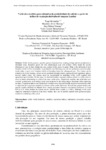Please use this identifier to cite or link to this item:
http://www.alice.cnptia.embrapa.br/alice/handle/doc/963264| Title: | Variáveis e modelos para estimativa da produtividade do cafeeiro a partir de índices de vegetação derivados de imagens Landsat. |
| Authors: | BERNARDES, T.  MOREIRA, M. A.   VERONA, J. D.   SHIMABUKURO, Y. E.   LUIZ, A. J. B.   |
| Affiliation: | TIAGO BERNARDES, CEMADEN; MAURÍCIO ALVES MOREIRA, INPE; JANE DELANE VERONA, INPE; YOSIO EDEMIR SHIMABUKURO, INPE; ALFREDO JOSE BARRETO LUIZ, CNPMA. |
| Date Issued: | 2013 |
| Citation: | In: SIMPÓSIO BRASILEIRO DE SENSORIAMENTO REMOTO, 16., 2013, Foz do Iguaçu. Anais... Foz do Iguaçu: INPE, 2013. p. 0720-0727. |
| Description: | Abstract. Coffee fields present a specific pattern of productivity resulting in high and low production in alternated years. Branches grown the first phenological year will produce coffee beans the second phenological year. In high-production years a plant works mostly to grain-filling to the detriment of new branches which will be responsible for production the following year. In low-production years the plant works rather to grow new branches which will produce beans the subsequent year. This feature can be related to the foliar biomass, which can be estimated through remote sensing derived vegetation indices. Several studies report this feature must be incorporated in modeling coffee yield coupled with agrometeorogical models. In this paper we derived Landsat vegetation indices related to coffee plots in order to obtain relationships to yield of the same coffee plots. Biophisical variables and yield data were colected in interviews with farmers from four locations in the whole largest Brazilian coffee-exporting province. Vegetation indices and biophysical variables were selected through stepwise regression in order to obtain the best regression models to estimate coffee yield. Outcomes showed that general models and specific models obtained for Mundo Novo variety presented Pearson's correlation coeficients (r) from 0,64 to 0,71 while models for Catuaí variety showed better results (r = 0,85). Although coffee yield cannot be estimated exclusively from these models, they can be usefull coupled with agrometeorogical models for estimating coffee yield. |
| Thesagro: | Café Produtividade Sensoriamento remoto |
| NAL Thesaurus: | Grain yield Agricultural management models Statistical models |
| Keywords: | Coffee yield Biophysics variables Vegetation indices Radiometric correction Stepwise regression Coffee |
| Type of Material: | Artigo em anais e proceedings |
| Access: | openAccess |
| Appears in Collections: | Artigo em anais de congresso (CNPMA)  |
Files in This Item:
| File | Description | Size | Format | |
|---|---|---|---|---|
| 2013AA03.pdf | 343.62 kB | Adobe PDF |  View/Open |









